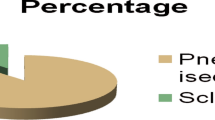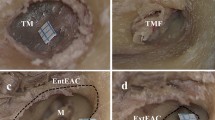Abstract
The Trans-labrynthine approach, through Otic capsule gives direct approach to the cerebellopontine angle (CPA) and internal auditory meatus (IAM) with preservation of the facial nerve. Mastering the approach to IAM in a cadaver with anatomical landmarks is important to the budding Otologist & Neurotologist to approach the CPA with functional preservation of the Facial nerve in patients with Vestibular Schwannoma & other procedures. Transitioning surgical skills and anatomic knowledge from surgical anatomy textbooks and laboratory training to the operative room is challenging. 30 adult wet human cadaveric temporal bones were studied by performing Trans-labrynthine approach to the IAM by using ZEISS microscope in a temporal bone dissection lab. Photographs were taken by HD phone camera, imported into computer & labeled the anatomical landmarks. Wide exposure & 3D visualization of complex anatomical landmarks were noted in each step by step approach from basic to advanced procedure of Trans-labrynthine approach to IAM. The step by step approach to the IAM from basic to advanced procedure in a cadaveric temporal bone offers great orientation & opportunity to become a master of the complex surgical anatomy of IAM and in acquiring a 3D orientation of the critical structures.










Similar content being viewed by others
References
Agirdir BV, Sindel M, Arslan G, Yildirim FB, Balkan EI, Dinç O (2001) The canal of the posterior ampullar nerve: an important anatomic landmark in the posterior fossa transmeatal approach. Surg Radiol Anat 23:331–334
Muren C, Wadin K, Dimopoulos P (1991) Radioanatomy of the singular nerve canal. Eur Radiol 1:65–69
Gonzalez LF, Lekovic GP, Porter RW, Syms MJ, Daspit CP, Spetzler RF (2004) Surgical approaches for resection of acoustic neuromas. Barrow Q. 20:4
Marchioni D, Alicandri-Ciufelli M, Mattioli F, Nogeira JF, Tarabichi M, Villari D, Presutti L (2012) From external to internal auditory canal: surgical anatomy by an exclusive endoscopic approach. Eur Arch Otorhinolaryngol 270:1267–1275
Yokoyama T et al (1996) Surgical approach to the internal auditory meatus in acoustic neuroma surgery: significance of preoperative high-resolution computed tomography. Neurosurgery 39(5):965–970
Shen T, Friedman RA, Brackmann DE, Slattery WH III, Hitselberger WE, Schwartz MS, Fisher L (2004) The evolution of surgical approaches for posterior fossa meningiomas. Otol Neurotol 25(3):394–397
Marques SR, Ajzen S, D’Ippolito G, Alonso L, Isotani S, Lederman H (2012) Morphometric analysis of the internal auditory canal by computed tomography imaging. Iran J Radiol 9:71–78
Acknowledgements
We thank the Department of Anatomy for providing the cadaveric temporal bones & Department of ENT & HNS for providing fully functional temporal bone dissection laboratory.
Funding
Nil.
Author information
Authors and Affiliations
Corresponding author
Ethics declarations
Conflict of interest
All authors declare that they have no conflict of interest.
Ethical Approval
Obtained.
Additional information
Publisher's Note
Springer Nature remains neutral with regard to jurisdictional claims in published maps and institutional affiliations.
Rights and permissions
Springer Nature or its licensor (e.g. a society or other partner) holds exclusive rights to this article under a publishing agreement with the author(s) or other rightsholder(s); author self-archiving of the accepted manuscript version of this article is solely governed by the terms of such publishing agreement and applicable law.
About this article
Cite this article
Damam, S.K., Harugop, A.K.S. Mastering the Trans-Labrynthine Approach to Internal Acoustic Meatus: A Cadaveric Temporal Bone Study. Indian J Otolaryngol Head Neck Surg 75 (Suppl 1), 127–132 (2023). https://doi.org/10.1007/s12070-022-03308-6
Received:
Accepted:
Published:
Issue Date:
DOI: https://doi.org/10.1007/s12070-022-03308-6




